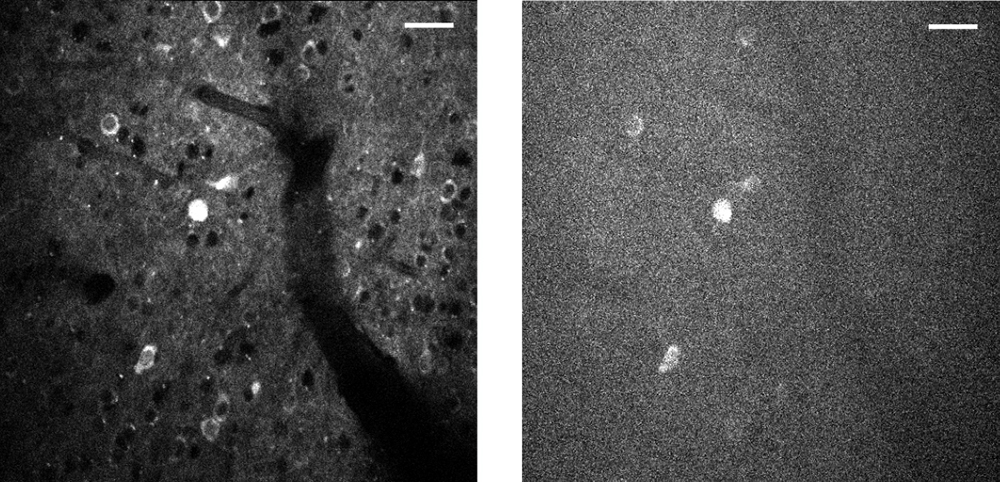Group develops deep, noninvasive imaging of mouse brain
By Tom Fleischman
Nearly four years ago, then-President Obama launched the BRAIN (Brain Research through Advancing Innovative Neurotechnologies) Initiative, to “accelerate the development and application of new technologies that will enable researchers to produce dynamic pictures of the brain.”
Several of the program’s initial funding awards went to Cornell’s Chris Xu, the Mong Family Foundation Director of Cornell Neurotech – Engineering, and professor and director of undergraduate studies in applied and engineering physics. Xu’s projects aimed to develop new imaging techniques to achieve large scale, noninvasive imaging of neuronal activity.
Three years later, his group’s efforts have yielded fruit. Xu’s research team reports clear, non-invasive imaging of activities of protein-labeled neurons in the subcortical region of the brain, beyond the limits of previous imaging technology.
The team ‘s work, “In vivo three-photon imaging of activity of GCaMP6-labeled neurons deep in intact mouse brain,” was released online Feb. 20 in Nature Methods.
Senior research associate Dimitre Ouzounov and doctoral student Tianyu Wang are co-lead authors of the paper. Other contributors include Nozomi Nishimura, assistant professor of biomedical engineering, doctoral students Mengran Wang, Nicholas Horton, Jean Cruz-Hernandez and Yu-Ting Cheng.
Four years ago, Xu and his group reported proof-of-concept of three-photon microscopy (3PM), which can probe deeper into the brain than standard two-photon microscopy (2PM). The latter was invented at Cornell in 1990 by engineering professor Watt Webb and then-doctoral student Winfried Denk.
Xu and Webb demonstrated the potential for 3PM in 1995, while Xu was a graduate student in Webb's lab. Xu’s doctoral thesis touched on this emerging technique, but it was “out of context” at the time, Xu said, without the proper laser technology.
In this work, Xu’s group demonstrates 3PM operating at a wavelength of 1,300 nanometers using a new laser that was specifically developed for 3-photon imaging by a commercial company with Xu’s guidance. The work recorded spontaneous activity from up to 150 neurons, labeled with a green fluorescent protein (GFP) based calcium sensor that makes the neuron glow bright green as it fires.

The combination of 3PM and the long excitation wavelength result in imaging that’s startlingly clear, compared to existing 2PM.
“We can see function; we can see how the mouse thinks,” Xu said. “Neuroscientists could potentially connect the blinking neurons to the behavior exhibited at that instance by the mouse.”
Previous attempts at imaging the hippocampus region required either removing the top portion of the brain, or inserting a glass plug through the brain, through which the subcortical region could be viewed. The concept Xu’s group proved in 2013 is further confirmed in this latest work.
“What we are able to do is leave the brain intact and go all the way down [to the hippocampus] to see this,” Xu said. “We were able to demonstrate this concept four years ago, but now we are saying that this is open for business, ready for neuroscience research.”
Xu is excited to be on the cutting edge of a technology that’s at “the intersection of physics, engineering and neuroscience,” he said. Being able to clearly image the hippocampus could have significant ramifications in the study of a host of brain diseases, including Alzheimer’s and Parkinson’s.
According to the Alzheimer’s Association, 5.3 million people in the U.S. were living with Alzheimer’s in 2016.
“Brain disease is probably going to bankrupt the country if we don’t get a handle on it,” Xu said. “People are living longer and longer, and nearly half the people above age 85 have some sort of dementia.”
Other collaborators in this work – supported by grants from the National Institutes of Health (NIH), the Defense Advanced Research Projects Agency (DARPA), and the Intelligence Advanced Research Projects Activity (IARPA) – came from the Department of Neuroscience at Baylor College of Medicine.
Media Contact
Get Cornell news delivered right to your inbox.
Subscribe